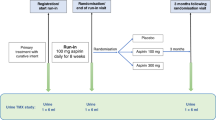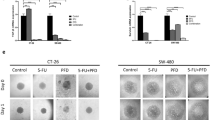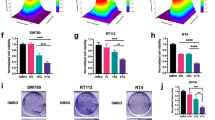Abstract
Recently, we reported prognostic significance of thromboxane synthase (TXAS) gene expression in invasive bladder cancer. The positive correlation between elevated TXAS expression and shorter patient survival supports a potential role for TXAS-regulated pathways in tumor metastases. In this study, using immunohistochemical analysis, we found an increased expression of TXAS protein in bladder cancer. Treatment of T24 and transitional cell carcinoma TCC-SUP bladder cancer cells with the TXAS inhibitors furegrelate or ozagrel induced an apoptotic effect measured as an increase in caspase-3 activation and cell death, and decreased survivin expression. Pharmacological inhibition of TXAS using the TXAS inhibitor furegrelate increased sensitivity to the chemotherapeutic agents cisplatin and paclitaxel. Molecular inhibition of TXAS expression by siRNA significantly decreased cell growth and migration. In concordance with the pharmacological data, siRNA-mediated reduction of TXAS expression increased sensitivity to cisplatin and paclitaxel in T24 and TCC-SUP cells. In summary, the data support a role for the thromboxane A2 pathway in the pathogenesis of bladder cancer and the potential utility of modulation of this signaling pathway for cancer chemotherapy.
This is a preview of subscription content, access via your institution
Access options
Subscribe to this journal
Receive 50 print issues and online access
$259.00 per year
only $5.18 per issue
Buy this article
- Purchase on Springer Link
- Instant access to full article PDF
Prices may be subject to local taxes which are calculated during checkout





Similar content being viewed by others
Accession codes
References
Bando T, Fujimura M, Kasahara K, Matsuda T . (1998a). Role of thromboxane receptor on the intracellular accumulation of cis-diamminedichloroplatinum(II) in non-small-cell but not in small-cell lung cancer cell lines. Anticancer Res 18: 1079–1084.
Bando T, Fujimura M, Kasahara K, Matsuda T . (1998b). Significance of Na+, K(+)-ATPase on intracellular accumulation of cis-diamminedichloroplatinum(II) in human non-small-cell but not in small-cell lung cancer cell lines. Anticancer Res 18: 1085–1089.
Bando T, Fujimura M, Kasahara K, Shibata K, Shirasaki H, Heki U et al. (1997). Exposure to sorbitol induces resistance to cisplatin in human non-small-cell lung cancer cell lines. Anticancer Res 17: 3345–3348.
Bokemeyer C, Hartmann JT, Kuczyk MA, Truss MC, Kollmannsberger C, Beyer J et al. (1998). Recent strategies for the use of paclitaxel in the treatment of urological malignancies. World J Urol 16: 155–162.
Calabro F, Sternberg CN . (2002). High-risk metastatic urothelial cancer: chances for cure? Curr Opin Urol 12: 441–448.
Giese A, Hagel C, Kim EL, Zapf S, Djawaheri J, Berens ME et al. (1999). Thromboxane synthase regulates the migratory phenotype of human glioma cells. Neuro-oncol 1: 3–13.
Hour TC, Chen J, Huang CY, Guan JY, Lu SH, Hsieh CY et al. (2000). Characterization of chemoresistance mechanisms in a series of cisplatin-resistant transitional carcinoma cell lines. Anticancer Res 20: 3221–3225.
Jantke J, Ladehoff M, Kurzel F, Zapf S, Kim E, Giese A . (2004). Inhibition of the arachidonic acid metabolism blocks endothelial cell migration and induces apoptosis. Acta Neurochir (Wien) 146: 483–494.
Jariyawat S, Takeda M, Kobayashi M, Endou H . (1997). Thromboxane A2 mediates cisplatin-induced apoptosis of renal tubule cells. Biochem Mol Biol Int 42: 113–121.
Jemal A, Siegel R, Ward E, Murray T, Xu J, Thun MJ . (2007). Cancer statistics, 2007. CA Cancer J Clin 57: 43–66.
Kamath K, Wilson L, Cabral F, Jordan MA . (2005). BetaIII-tubulin induces paclitaxel resistance in association with reduced effects on microtubule dynamic instability. J Biol Chem 280: 12902–12907.
Kasahara K, Fujimura M, Bando T, Shibata K, Shirasaki H, Matsuda T . (1996). Modulation of sensitivity to cis-diamminedichloroplatinum (II) by thromboxane A2 receptor antagonists in non-small-cell lung cancer cell lines. Br J Cancer 74: 1553–1558.
Kim E, Gunther W, Yoshizato K, Meissner H, Zapf S, Nusing RM et al. (2003). Tumor suppressor p53 inhibits transcriptional activation of invasion gene thromboxane synthase mediated by the proto-oncogenic factor ets-1. Oncogene 22: 7716–7727.
Moussa O, Yordy JS, Abol-Enein H, Sinha D, Bissada NK, Halushka PV et al. (2005). Prognostic and functional significance of thromboxane synthase gene overexpression in invasive bladder cancer. Cancer Res 65: 11581–11587.
Murphy S, Welk G, Thwin SS . (1990). Stimulation of thromboxane release from primary cell cultures derived from human astrocytic glioma biopsies. Glia 3: 205–211.
Nie D, Che M, Zacharek A, Qiao Y, Li L, Li X et al. (2004). Differential expression of thromboxane synthase in prostate carcinoma: role in tumor cell motility. Am J Pathol 164: 429–439.
Pascual J, Sterin-Borda L, Wald M, Borda ES . (1988). TXB2: cardiostimulant effect that involves beta-adrenoceptor and Na++K+-ATPase activity. Prostaglandins Leukot Essent Fatty Acids 33: 53–59.
Pradono P, Tazawa R, Maemondo M, Tanaka M, Usui K, Saijo Y et al. (2002). Gene transfer of thromboxane A(2) synthase and prostaglandin I(2) synthase antithetically altered tumor angiogenesis and tumor growth. Cancer Res 62: 63–66.
Sakai H, Suzuki T, Takahashi Y, Ukai M, Tauchi K, Fujii T et al. (2006). Upregulation of thromboxane synthase in human colorectal carcinoma and the cancer cell proliferation by thromboxane A2. FEBS Lett 580: 3368–3374.
Schiff PB, Fant J, Horwitz SB . (1979). Promotion of microtubule assembly in vitro by taxol. Nature 277: 665–667.
Stein JP, Lieskovsky G, Cote R, Groshen S, Feng AC, Boyd S et al. (2001). Radical cystectomy in the treatment of invasive bladder cancer: long-term results in 1,054 patients. J Clin Oncol 19: 666–675.
Wald M, Pascual J, Sterin-Borda L . (1989). Role of thromboxanes in alterations of the diabetic beta-adrenergic system. Biochem Pharmacol 38: 3347–3355.
Watkins G, Douglas-Jones A, Mansel RE, Jiang WG . (2005). Expression of thromboxane synthase, TBXAS1 and the thromboxane A2 receptor, TBXA2R, in human breast cancer. Int Semin Surg Oncol 2: 23.
Winston JA, Safirstein R . (1985). Reduced renal blood flow in early cisplatin-induced acute renal failure in the rat. Am J Physiol 249: F490–F496.
Yoshizato K, Zapf S, Westphal M, Berens ME, Giese A . (2002). Thromboxane synthase inhibitors induce apoptosis in migration-arrested glioma cells. Neurosurgery 50: 343–354.
Acknowledgements
We acknowledge the technical assistance of Alex McPherson, Margaret Romano (Hollings Cancer Center Tumor Bank) and Rick Peppler (Flow Cytometry Facility).
Author information
Authors and Affiliations
Corresponding author
Rights and permissions
About this article
Cite this article
Moussa, O., Riker, J., Klein, J. et al. Inhibition of thromboxane synthase activity modulates bladder cancer cell responses to chemotherapeutic agents. Oncogene 27, 55–62 (2008). https://doi.org/10.1038/sj.onc.1210629
Received:
Revised:
Accepted:
Published:
Issue Date:
DOI: https://doi.org/10.1038/sj.onc.1210629
Keywords
This article is cited by
-
Thromboxane A2 exerts promoting effects on cell proliferation through mediating cyclooxygenase-2 signal in lung adenocarcinoma cells
Journal of Cancer Research and Clinical Oncology (2014)
-
Genomic polymorphisms of SLC29A3 associated with overall survival in advanced non-small-cell lung cancer treated with gemcitabine
Medical Oncology (2014)
-
Thromboxane A2 modulates cisplatin-induced apoptosis through a Siva1-dependent mechanism
Cell Death & Differentiation (2012)
-
Examination of thromboxane synthase as a prognostic factor and therapeutic target in non-small cell lung cancer
Molecular Cancer (2011)
-
4-Methylnitrosamino-1-3-pyridyl-1-butanone (NNK) promotes lung cancer cell survival by stimulating thromboxane A2 and its receptor
Oncogene (2011)



